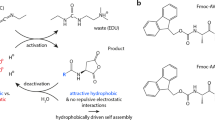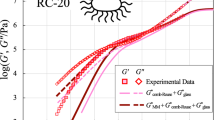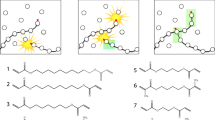Abstract
In this work, we discuss the dynamic viscoelasticity of three novolac resins with different molar masses and methylene linkage patterns (para–para′, ortho–ortho′ and ortho–para′ methylene linkages) to clarify the relationship between the structure and viscoelastic properties of novolac resins. The linkage patterns of the novolacs were evaluated using 13C nuclear magnetic resonance spectroscopy. Gel permeation chromatography (GPC) measurements showed that the number density distribution was similar to that predicted for hyperbranched chains. The dependence of the intrinsic viscosity on the molar mass indicated that the three novolacs had a compact branched chain structure similar to that of hyperbranched chains. The glass transition temperatures determined by differential scanning calorimetry (DSC) depended on the molar mass and were less sensitive to the methylene linkage pattern. The viscoelastic spectra obtained by the time–temperature superposition principle for the three resins were similar to each other because the glassy relaxation properties were dominant. Weak polymeric modes originating from the chain connectivity were observed at low frequencies in the composite curve and were well described by the dynamic scaling theory for hyperbranched chains. A clear effect from the linkage patterns on the mechanical properties was not observed.
Similar content being viewed by others
Log in or create a free account to read this content
Gain free access to this article, as well as selected content from this journal and more on nature.com
or
References
Gardziella, A., Pilato, L. A. & Knop, A. Phenolic Resins: Chemistry, Applications, Standardization, Safety and Ecology, (Springer, Berlin, 1999).
Stauffer, D. & Aharony, A. Introduction to Percolation Theory, (Taylor and Francis, London, 1992).
de Gennes, P. G. La percolation: Un concept unificateur. Recherche 7, 919–927 (1976).
Rubinstein, M. & Colby, R. H. Polymer Physics 320 (Oxford University Press, 2003).
Ginzburg, V. L. Some remarks on second order phase transitions and microscopic theory of ferroelectrics. Fiz. Tverd, Tela 2, 2031–2043 (1961).
de Gennes, P. G. Critical behaviour for vulcanization processes. J. Phys. (France) Lett. 38, 355–358 (1977).
Daoud, M. Vulcanization and critical exponents. J. Phys. (France) Lett. 40, 201–205 (1979).
Flory, P. J. Molecular size distribution in three dimensional polymers. I. Gelation1. J. Am. Chem. Soc. 63, 3083–3090 (1941).
Stockmayer, W. H. Theory of molecular size distribution and gel formation in branched–chain polymers. J. Chem. Phys. 11, 45–55 (1943).
Stockmayer, W. H. Theory of molecular size distribution and gel formation in branched polymers II. General cross linking. J. Chem. Phys. 12, 125–131 (1944).
Stauffer, D., Coniglio, A. & Adam, M. Gelation and critical phenomena. Adv. Polym. Sci. 44, 103–158 (1982).
de Gennes, P.-G. Scaling Concepts in Polymer Physics, (Cornell University Press, Ithaca, NY, 1979).
Lusignan, C. P., Mourey, T. H., Wilson, J. C. & Colby, R. H. Viscoelasticity of randomly branched polymers in the critical percolation class. Phys. Rev. E 52, 6271–6280 (1995).
Lusignan, C. P., Mourey, T. H., Wilson, J. C. & Colby, R. H. Viscoelasticity of randomly branched polymers in the vulcanization class. Phys. Rev. E 60, 5657–5669 (1999).
Inoue, T., Okamoto, H. & Osaki, K. Birefringence of amorphous polymers I dynamic measurement on polystyrene. Macromolecules 24, 5670–5675 (1991).
Schroter, K., Hutcheson, S. A., Shi, X., Mandanici, A. & McKenna, G. B. Dynamic shear modulus of glycerol: corrections due to instrument compliance. J. Chem. Phys. 125, 214507 (2006).
Hutcheson, S. A. & McKenna, G. B. The measurement of mechanical properties of glycerol, m-toluidine, and sucrose benzoate under consideration of corrected rheometer compliance: an in-depth study and review. J. Chem. Phys. 129, 074502 (2008).
Ferry, J. D. Viscoelastic Properties of Polymers 264–320 (Wiley, 1980).
Schosseler, F., Benoit, H., Grubisic-Gallot, Z., Strazielle, C. & Leibler, L. Gelation process by size-exclusion chromatography coupled with light scattering. Macromolecules 22, 400–410 (1989).
Ottavi, H. Amplitude ratio of the second moments of the cluster size distribution on both sides of the percolation threshold. J. Phys. A 20, 1015–1020 (1987).
Maeda, N. & Norisuye, T. On the unperturbed dimensions of bisphenol A polycarbonate. Polymer 34, 3475–3480 (1993).
Yamakawa, H. Modern Theory of Polymer Solutions 434 (Harper & Row Publishers, 1971).
Weissmüller, M. & Burchard, W. Viscosity of fractions from end-linked polystyrene star macromolecules. Acta Polym. 48, 571–578 (1997).
Inoue, T., Onogi, T. & Osaki, K. Viscoelasticity of low molecular weight polystyrene. Separation of rubbery and glassy components. J. Polym. Sci. Polym. Phys. Ed. 37, 389–397 (1999).
Rubinstein, M., Colby, R. H. & Gillmor, J. R. Space-Time Organization in Macromolecular Fluids 66–74 (Springer, 1989).
Inoue, T. & Osaki, K. Role of polymer chain flexibility on the viscoelasticity around the glass transition zone. Macromolecules 29, 1595–1599 (1996).
Tamura, E., Kawai, Y., Inoue, T., Matsushita, A. & Okamoto, S. Dynamic birefringence and non-linear rheology of diblock copolymer micellar solutions. Soft Matter 8, 6161–6166 (2012).
Tamura, E., Kawai, Y., Inoue, T. & Watanabe, H. Rheo-optical study of viscoelastic relaxation modes in block copolymer micellar lattice system. Macromolecules 45, 6580–6586 (2012).
Inoue, T., Matsumoto, A. & Nakamura, K. Dynamic viscoelasticity and birefringence of poly(ionic liquids) in the vicinity of glass transition zone. Macromolecules 46, 6104–6109 (2013).
Maeda, A., Inoue, T. & Sato, T. Dynamic segment size of the cellulose chain in an ionic liquid. Macromolecules 46, 7118–7124 (2013).
Acknowledgements
This study was partly supported by Grant-in-Aid for Scientific Research (No. 24350120) from the Japan Society for the Promotion of Science.
Author information
Authors and Affiliations
Corresponding author
Additional information
Supplementary Information accompanies the paper on Polymer Journal website
Supplementary information
Rights and permissions
About this article
Cite this article
Maji, S., Urakawa, O. & Inoue, T. The structure and viscoelasticity of novolac resins. Polym J 46, 584–591 (2014). https://doi.org/10.1038/pj.2014.27
Received:
Revised:
Accepted:
Published:
Issue date:
DOI: https://doi.org/10.1038/pj.2014.27



